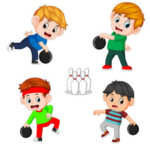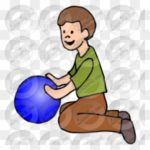
by Neetu | Jun 2, 2021 | Manthan
Learning Outcome
This activity develops dynamic balance, coordination, rhythm, and timing required for any and all sports and activities that involve a running jump (e.g., basketball, baseball, soccer, volleyball, track and field, gymnastics).
Activity Description
Stretch out two ropes or lengths of ribbon on the ground.
Use the ropes or ribbons to form a single large “V” with a 1-meter space at the bottom of the “V”.
The space between the two ropes or ribbons is the river.
Take turns running and leaping over the river.
Start by leaping at the narrow part of the river, and then try to leap wider parts.
TIP: Show your child how to take off with one foot and land with two feet while bending the knees.
Variations
Pretend there are crocodiles in the river – if you fall in the river, roll around on the grass and pretend you are wrestling a crocodile!
If your child always takes off with one foot, make sure they practice taking off with the other foot as well
Required Material
4 Boundary cone, Two long skipping ropes or lengths of ribbon
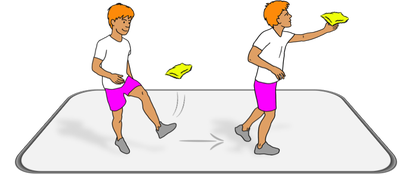
by Neetu | Jun 2, 2021 | Manthan
Learning Outcome
This activity develops throwing.
Activity Description
Place a start marker on the floor with the first hula hoop approximately 3-4 meters away. This is the first golf hole.
Place your next start marker near the first hoop with the second hoop approximately 3-4 meters away. This is your second golf hole.
Continue to place more markers and hoops to create as many golf holes as you want.
Starting at the first marker, participants try to throw their bean bags into the first hoop.
If their bean bag misses the hoop, participants retrieve their bean bag, return to the start line, and throw again until the bean bag lands in the hoop.
Participants move to the next start marker and play the next golf hole.
The game ends when all participants have gotten their bean bags into all the hoops and completed the entire golf course.
Variations
If you want to add a bit of competition, record each player’s total number of throws at each hole. The winner is the player with the lowest score at the end of the game.
Required Material
4 Boundary cone, marker, bean bag, hoop
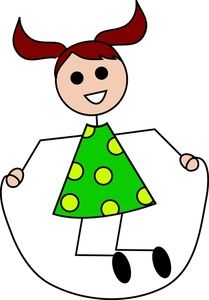
by Neetu | Jun 2, 2021 | Manthan
Learning Outcome
Exploring skipping through different pathways and levels, skipping to a rhythm, and relationships (with others).
Activity Description
Children practise different skipping actions. Ask them to show you how they can skip. Provide the following suggestions for them to explore skipping further.
Can you skip …? • like a giant, a fairy, a clown, a toy soldier • making yourself very small and gradually getting taller • being as tall as you can • forwards/sideways/backwards • happily/angrily/sadly, tightly/loosely • quickly/slowly, at varying speeds • in a straight line, in a curved pathway, in a circle, in a figure of 8 • as fast or as slowly as you can, downhill or uphill • without using your arms – now swing your arms outwards, inwards and diagonally • to the beat of the drum or to music • without touching any lines on the floor, or cracks on the concrete • and see how many skips it takes for you to get from ‘here’ to ‘there’ • with a partner – going backwards while your partner goes forwards, holding hands so you both skip around on the spot What are some other ways you can skip?
Can you see …? • fun • creativity • children coming up with their own ideas You could ask … What did you enjoy the most about skipping? How did you and your partner skip together?
Variations Follow the leader: One child is the leader who the others follow on a skipping journey
Required Material
4 Boundary cone, Skipping rope
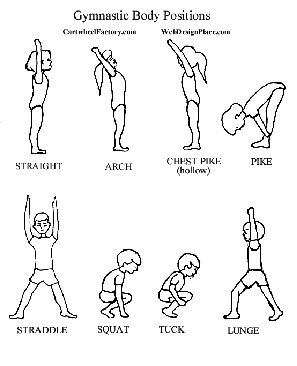
by Neetu | Jun 2, 2021 | Manthan
Learning Outcome
Students will participate in gymnastics stunts, using different parts of their bodies to balance. Students will work cooperatively with their partners on gymnastics mats to complete balancing activities.
Activity Description
Introduction: Introduce gymnastics and the concept of balance. •Have you ever heard the word gymnastics? •Who can explain what it is? •Have you seen gymnastics on TV? •Have you participated in a gymnastics class? •What kind of things do you learn in gymnastics? •Balance – that’s right, what does that mean? (hold perfectly still without moving) •You’ve got the right idea, today we are going to explore different types of balance activities used in gymnastics called stunts. Discussion of safety and comfort during activity.
Activity #1: Stork Stand •Directions: stand with your feet shoulder-width apart, balance on one foot with your arms tucked in like a stork’s feathers. •Have students practice the above balance in their own self space several times. Can they hold the balance for a count of 10? •Students spin around in circles until they hear the whistle and then try to get into the stork stand. How long can you balance this time? •Students spin in circles again and when they hear the whistle, they close their eyes and try to stand in the stork stand position. How long can you balance this time?
Activity #2: Airplane •Directions: stand on one leg with arms out the sides, like a T, raise your back leg as high as you can, keep your head up. Try not to lean forward. How long can you hold this balance?
Activity #3: Finger Touch •Directions: stand with feet shoulder-width apart. Place one hand behind your back with your pointer finger pointing down. Reach around your back with the other hand and grab the wrist of the first hand. Now try to squat down and touch the floor with the pointed finger without falling over. Can you do it? •Switch hands and try again?
Activity #4: Log Roll •Directions: lay down across the width of the mat with your arms straight against your side. Try to roll straight down the mat like a log. •Can you roll very slowly? Can you roll very quickly? Are you staying straight?
Required Material
4 Boundary cone, Mat, Ribbon

by Neetu | Jun 1, 2021 | Manthan
Learning Outcome
To help students to practice their foot agility and body control.
Activity Description
Divide the class equally depending upon the number of stations you have (keep numbers to 2 or 3) and assign them a starting station. Moving in a clockwise rotation around the room, have students read the card and perform that skill through the agility ladder. When they have finished have the group move to the next ladder, read the card, and do the next skill through that particular ladder. Continue around the room until they have finished all stations.
Rules: Wait until the player in front of you is halfway through the ladder before you “GO.” Do not pass!
Station Cards:
Kangaroo Jump – jump with both feet in each ladder space.
Flamingo Hop – hop on the same foot through the ladder.
Hip Hop – hop on one foot into the first ladder space, hop on the other into the next space – alternate feet.
Slide-facing sideways move the leading foot into space, the second foot follows into the same space then move the leading foot into the next space.
Hopscotch – hop on one foot into the first ladder space, in the next ladder space land on two feet spread apart (straddle), hop on one foot in the next space. Repeat this hop/jump pattern until you complete the ladder.
Horse – use a gallop – place the leading foot in the first space, follow with the other foot into the same space.
Required Material
4 Boundary cone, agility ladders

by Neetu | Jun 1, 2021 | Manthan
Learning Outcome
Follow directions by keeping control of football and body to keep safe and active
Activity Description
This should be familiar to most U6’s. Again, the game is fun, simple to set up, and has direct application to the game of soccer. It is particularly good for reinforcing dribbling and ball control skills.
Each player has a ball, except the one player that is designated as the “light”.
Players start from the line opposite the “light”.
The “light” then turns away from the group shouting out “GREEN LIGHT”.
At this signal, the players start to dribble towards the “light”.
When the “light” turns around, calling “RED LIGHT”, players must freeze and stop their ball.
If the “light” catches players or a ball still moving that player must take 5 steps back.
The first player to cross the line where the “light” is standing is the winner and becomes the new “light”.
Note: – You can start the game without using balls for younger players, then have them roll the ball with their hands, then use their feet.
The following games will be enjoyed by all children, especially (but not exclusively) the very young.
Required Material
4 Boundary cone. plastic football









